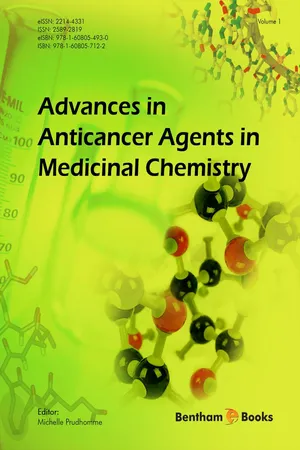
- English
- ePUB (mobile friendly)
- Available on iOS & Android
Advances in Anticancer Agents in Medicinal Chemistry: Volume 1
About this book
Advances in Anticancer Agents in Medicinal Chemistry is an exciting eBook series copmrising a selection of updated articles previously published in the peer-reviewed journal Anti-Cancer Agents in Medicinal Chemistry. The first volume presents reviews of many classes of drugs of contemporary interest for cancer therapy and is devoted to small inhibitors of various proteins involved in cancer development such as casein kinase 2 (CK2), protein kinase B (PKB), mTOR, Hsp90, P-glycoprotein (P-gp), kinesin spindle protein (KSP), cyclooxygenase 2 (COX-2), histone deacetylase enzymes (HDACs) and topoisomerase I.
Advances in Anticancer Agents in Medicinal Chemistry will be of particular interest to readers interested in anticancer drug therapy as the series provides relevant reviews written by experts in this important field.
Frequently asked questions
- Essential is ideal for learners and professionals who enjoy exploring a wide range of subjects. Access the Essential Library with 800,000+ trusted titles and best-sellers across business, personal growth, and the humanities. Includes unlimited reading time and Standard Read Aloud voice.
- Complete: Perfect for advanced learners and researchers needing full, unrestricted access. Unlock 1.4M+ books across hundreds of subjects, including academic and specialized titles. The Complete Plan also includes advanced features like Premium Read Aloud and Research Assistant.
Please note we cannot support devices running on iOS 13 and Android 7 or earlier. Learn more about using the app.
Information
Recent Advances in Hsp90 Inhibitors as Antitumor Agents
Samir Messaoudi*, Jean F. Peyrat*, Jean D. Brion, Mouâd Alami
Abstract
* Address correspondence to Samir Messaoudi and Jean F. Peyrat: Univ. Paris-Sud, CNRS, BioCIS-UMR 8076, Laboratoire de Chimie Thérapeutique, Faculté de Pharmacie, IFR 141, 5 rue J.-B. Clément, Châtenay-Malabry, F-92296, France; Tel: (33) 1 46 83 56 83; E.mail: [email protected] and Tel: (33) 1 46 83 58 86; Fax: (33) 1 46 83 58 28; E-mail: [email protected]
Introduction
Table of contents
- Welcome
- Table of Contents
- Title
- BENTHAM SCIENCE PUBLISHERS LTD.
- FOREWORD
- PREFACE
- Casein Kinase 2 (CK2) Inhibitors: Emerging Anticancer Therapeutic Agents?
- An Update 2009 – 2012 to “Targeted Small-Molecule Inhibitors of Protein Kinase B as Anticancer Agents”
- Advances in mTOR Inhibitors
- Recent Advances in Hsp90 Inhibitors as Antitumor Agents
- Recent Developments of P-gp Inhibitors
- Progress Review on Kinesin Spindle Protein Inhibitors as Anti-Cancer Agents
- Discovery of Allosteric Inhibitors of Kinesin Spindle Protein (KSP) for the Treatment of Taxane-Refractory Cancer: MK-0731 and Analogs
- Selective Cyclooxygenase-2 Inhibitors for Malignant Glioma Therapy: Molecular Targets Beyond COX-2
- Histone Deacetylase Inhibitors: Their Structure, Function and Potential to Treat Cancer
- Inhibiting Topoisomerase I, an Emerging Treatment for Primary CNS Malignancies